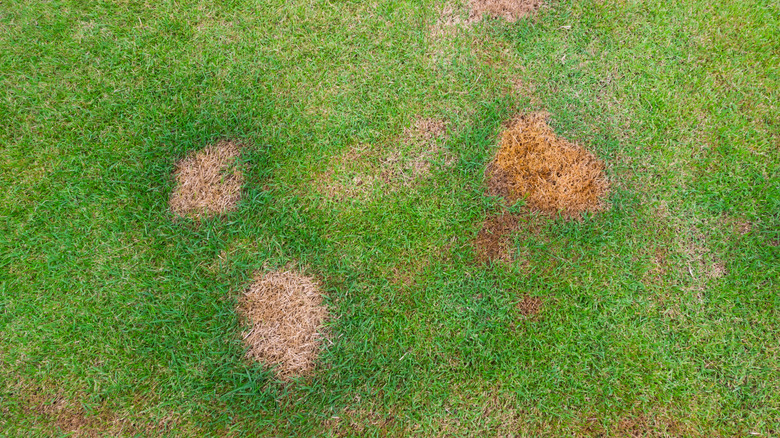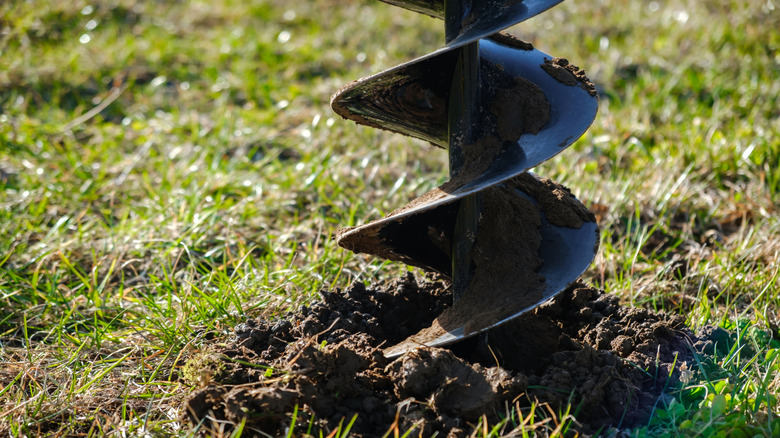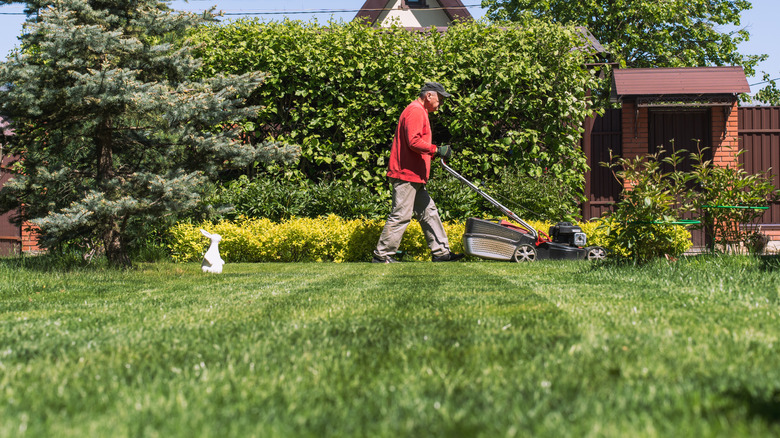The Unexpected Power Tool That Can Bring Your Patchy Yard Back To Life
There are few things more frustrating than working hard to make your lawn look good ... and then finding it marred by brown, unsightly patches. If you're struggling with dead grass, the cure might be in your toolbox. Your handy electric drill can be used to aerate your lawn and help turn brown spots green.
Aeration is an essential part of lawn care. Over time, dead grass and roots can form a layer of thatch between the soil and the green grass. This can choke new growth, and aeration — or making small holes in your yard — can help combat thatch build up. The holes are most effective when you also remove small pits of soil to give better air and water circulation to your living grass. Aeration also can break up soil in your yard that might be too compact and could be squeezing your grass roots. Soil can squash those roots, especially in areas where your lawn has a lot of foot traffic or if you already have dense clay soil.
There are lots of tricks about how to grow a lawn from poor soil, but all lawns can get a boost from aeration, which can help improve drainage so that water doesn't pool in corners of your lawn or drown your grass. Aeration gives roots a little more space to grow stronger and spread, helping your grass crowd out ugly weeds, too. But luckily for you, aerating your lawn can be easy, and you won't have to run out and buy a more expensive aeration tool. All you need is your drill and an auger attachment.
Know this before you aerate
Before you grab your drill, know that the best time to aerate for most kinds of grass is typically the fall, when the soil is soft but not muddy. Certain kinds of grass might want aeration and reseeding at different times of the year, however. Kentucky bluegrass, perennial ryegrass, and tall fescue love the fall for aeration, but St. Augustine and Bermuda grass prefer late spring or early summer. Never aerate a dormant lawn, as that can kill your grass.
Once you decide the timing is right, aerating is easy. Simply slip the auger attachment onto your drill, power it up, and poke holes about 2 to 4 inches deep and 2 to 6 inches apart. Target brown patches of grass first. After poking holes, add in some more grass seeds and then water, so you can give any new sprouts a chance to take hold. If it's the spring, you can also add in fertilizer. You can learn how to make the best homemade liquid lawn fertilizer with beer and ammonia.
And after aerating is done, don't be so quick to stash your drill. The power tool can be used in your garden in other ways as well. You can buy special gardening auger drill bits, which come in all sizes and shapes, including ones designed to help you plant bulbs or vegetables in the garden.
More hacks to treat brown spots
The drill can be a useful tool in the garden, but if you use it to aerate your lawn and you still don't get results, then the brown spots in your grass might need different treatments. The most common cause of brown spots on your lawn is a lack of water, so make sure that your yard is getting adequate moisture, either from your hose, sprinkler, or rain. Most lawns need about 1 ½ inches of water a week. Overfertilization can be another cause of ugly brown spots, too, but you can learn how to repair a lawn from too much fertilizer in a few easy steps. Grass needs nutrients, but overfertilization can brown your grass.
Even our most beloved pets can be another cause of brown spots in your grass. If dogs roam free in the yard, then the nitrogen in their urine can kill patches of grass. You'll know a dog might be to blame if you find a dark green circle of grass right around the dead spot. You can flush urine out of the grass by using extra water on spots after the dog goes. This can dilute the nitrogen, as can slight changes to your dog's diet, like including less processed and more natural foods. Grubs are also a culprit of brown spots in your grass, as they love to eat grass roots, which causes the blades to die.


